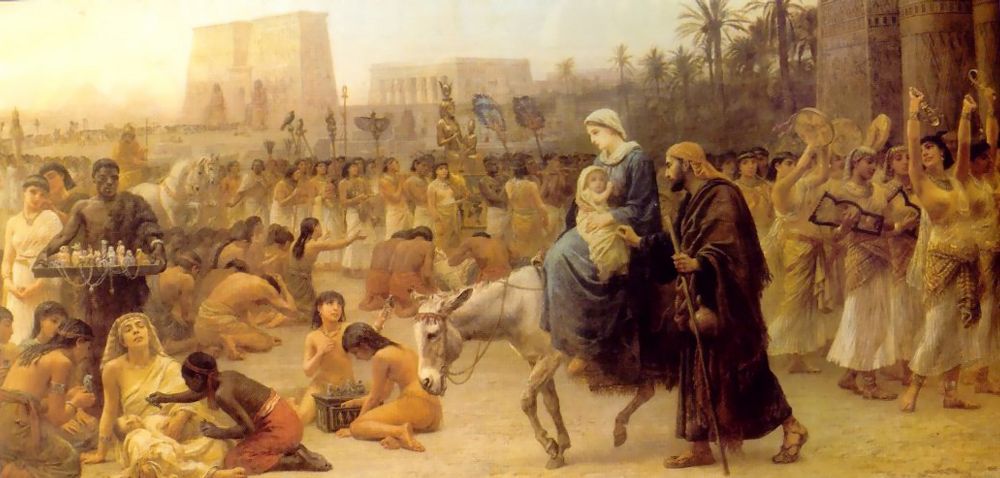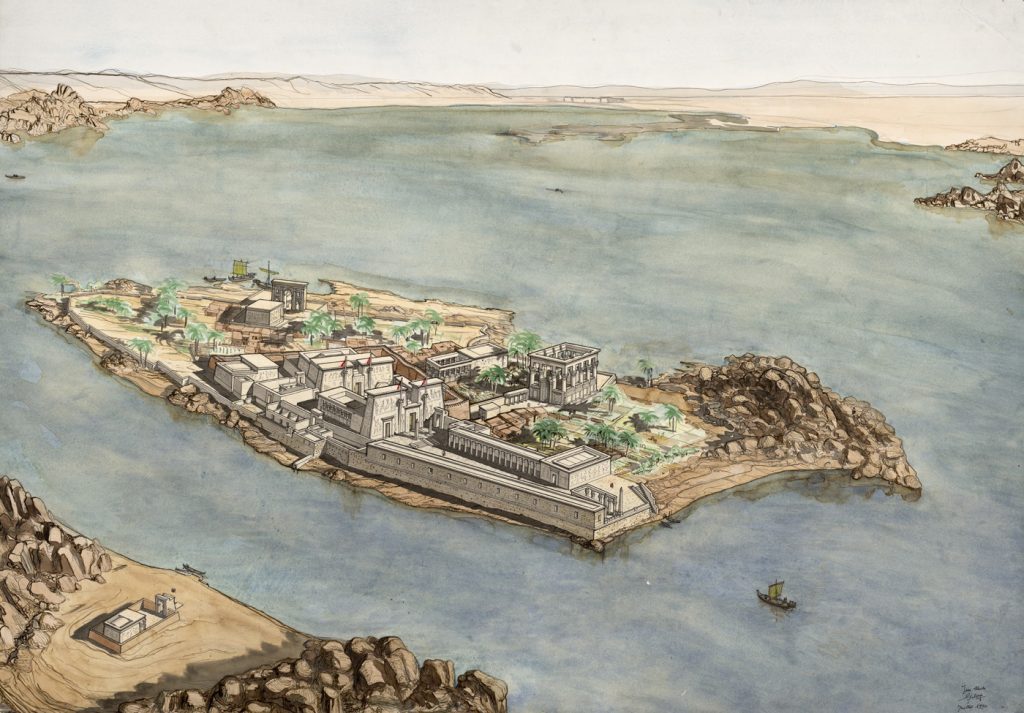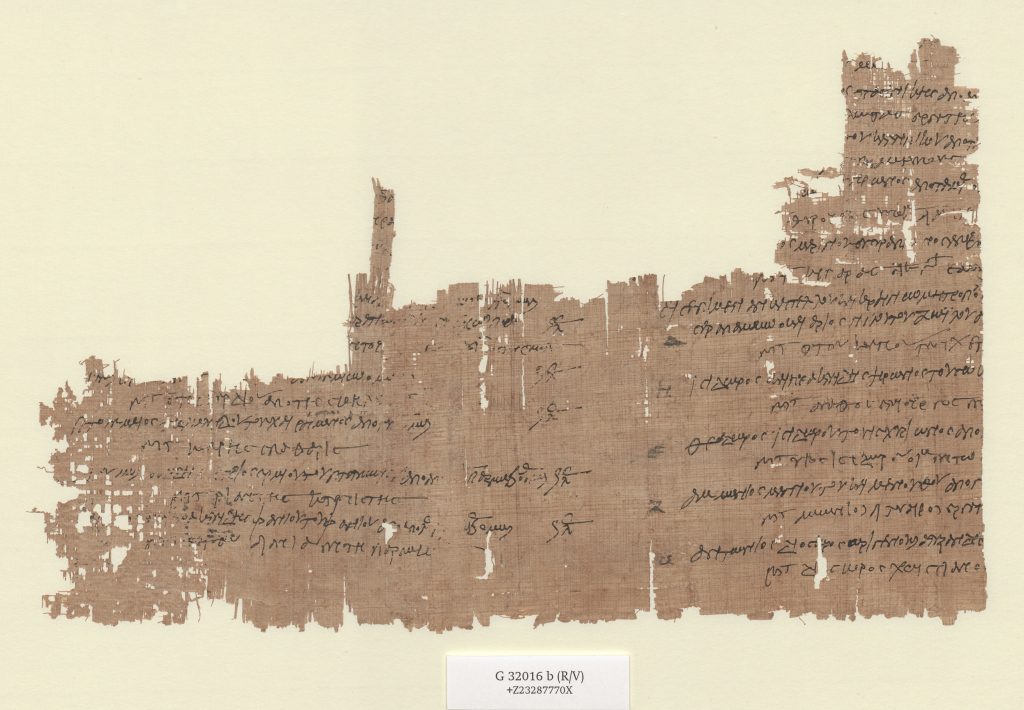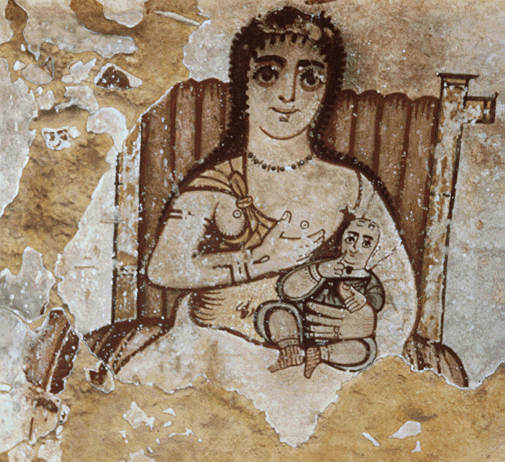
Anno Domini by Edwin Longsden (1883)
An Orientalist depiction of the arrival of Mary, Joseph and Jesus in Egypt, portraying a stark contrast between the traditional Egyptian cults and the new religion.
Religion and magic have a complicated relationship; Jewish and later Christian law often banned practices that were understood as magic, but as we saw in the previous post, Coptic magical texts are full of “religious” elements – mentions of the Christian Trinity, the saints and angels. The period that we are studying in this project – roughly the fourth to twelfth centuries CE – was one that saw huge religious changes in Egypt, and magical texts offer us a fascinating perspective on these changes. This post will briefly sketch how Egypt turned from a “pagan” society into Christian society over the course of the first through fifth centuries CE. In later posts we will discuss the diverse forms of Egyptian Christianity, and how this Christian society later became a largely Muslim one, while retaining significant Christian and Jewish minorities.

At the beginning of the fourth century, the majority of the Egyptian population probably followed the traditional gods who had been worshipped in Egypt for thousands of years – Osiris, the god of fertility and the afterlife; Isis, his wife, a goddess of motherhood and magic; their son Horus, god of kingship and the sun, and dozens, if not hundreds, of other national and local deities. While this religious tradition was old, it was never static, and the pantheon had seen both changes in the importance of certain deities, and the appearance of new gods, such as Petbe, the god of justice, Shai, the god of fate, and Tutu, a guardian sphinx god – to name but a few of those who seem to have been important in the Roman period.
But evidence for the practice of the traditional Egyptian cults almost entirely disappears by the mid-fourth century. The reasons for this are controversial, but a large part of the responsibility can probably be assigned to the Roman rulers of Egypt. Roman rule had begun with the victory of Octavian, later known as Augustus, the first emperor, over the famous Cleopatra VII and her lover Anthony in 31 BCE. While the Ptolemaic Dynasty, of which Cleopatra was the last ruler, had relied on the ideological and political support of the Egyptian temples, the Roman emperors tended to use local city elites as their partners in governing the empire in Egypt, as they did elsewhere. While they continued to support the temples, they did so at a much reduced scale, and their financial support gradually dried up in the course of the third century. With much reduced economic and political power, most of the temples seem to have closed by the third century – although there are notable and important exceptions, such as the temples of Isis at Philae in the south and Menouthis in the north. These temples survived at least into the fifth century, albeit at a much smaller scale; in the end the huge temple of Philae had only two priests, who shared the same name and were probably from a single family.
The second piece of the puzzle, also linked to Roman policy, was the rise of Christianity. According to the Church’s own history, it was the evangelist Mark, author of the gospel of the same name, who brought Christianity to Alexandria in the late first century. The earliest Christians, in Egypt as elsewhere, were probably Jewish converts, although the religion quickly spread among the Gentile population. While Alexandrian Christianity thrived, producing such important theologians as Clement of Alexandria (ca.150-ca.215 CE) and Origen (ca. 185/6-254 CE) in the second and third centuries, it was not until the time of Demetrius, patriarch of Alexandria from 189-232 CE, that it began to expand in earnest in the rest of Egypt, and our first documentary papyri mentioning Christians appear in the third century. The major turning point came with the reign of Constantine (306-337 CE), the first emperor to openly support Christianity, resulting in an explosion in the number of Christians. In the fifty years from 300 to 350 CE they may have increased from around 10-20% of the population to closer to 50%, and the earliest surviving churches from Egypt date to this time

Towards the end of the fourth century CE, Roman emperors began to ban key aspects of traditional religious practice such as sacrifice, and by the end of the fifth century Egypt was probably almost entirely Christian. Again, there are some important exceptions – there was a famous group of philosophical “pagans” in Alexandria, who combined Greek Late Platonic philosophy with Egyptian theology; the most famous of these is Horapollo the Younger (active around 500 CE), who wrote the Hieroglyphica, a Greek-language treatise on hieroglyphs of questionable accuracy. These are probably best understood as interesting exceptions to the general rule, and even Horapollo seems to have converted to Christianity later in life.
Exactly how this process of Christianisation happened, and what survived of older beliefs and practices, is an important question, and a difficult one to answer. There are several important moments of conflict between Christianity and “paganism” – the best known is the destruction of the temple of Serapis in Alexandria by Christians in 391 CE, and the murder in 415, of the Alexandrian philosopher Hypatia by a Christian mob; these events form the key events in the film Agora, which depicts Hypatia as a kind of martyr for science in the face of Christian intolerance. But while some conflict undoubtedly existed, the magical papyri allow us to see another side of these processes.

Hamzeh Carr, KM 200322)
P.Mich.inv. 4932 is a short recipe for a love spell, dating to the fifth or sixth century CE, after the traditional cults had almost certainly disappeared. The invocation, spoken over oil, calls upon the liquid to go forth and bring the spell’s victim to the feet of the user – a fairly typical Coptic love spell. The text begins by telling of the wondrous origins of the oil, describing it as flowing from beneath the throne of Iao Sabaoth, the Graeco-Coptic form of the name of the Jewish-Christian god, Yahweh Lord of Hosts. It ends with a description of the Christian underworld, inhabited by the Devil and by Temelouchos, the angel of divine punishment. But it also mentions the old Egyptian gods Isis and Osiris, describing how Isis used the same oil to anoint her husband’s corpse – perhaps drawing upon the myth which told how she used magic to conceive their son after Osiris’ death. While this text does not prove that the traditional cults still persisted at the time that it was copied, it does tell us that at least some pieces of Egyptian myths were still being transmitted. The spell’s composer drew upon both traditions – Christian and Egyptian – to describe the oil’s miraculous power to compel love.
While such mentions of traditional deities are relatively rare in Coptic texts, those that we do find are very interesting for our understanding of the development of the Coptic magical tradition, and of its ability to transmit and preserve knowledge of cults which had been lost in previous centuries.
Further Reading
Choat, Malcolm. “Christianity”. In The Oxford Handbook of Roman Egypt, edited by Christina Riggs. Oxford: Oxford University Press (2012), pp.474-489.
Overview of the history of the early Christianity in Egypt (1st-4th centuries CE).
Depauw, Mark and Clarysse, Willy. “How Christian was Fourth Century Egypt? Onomastic Perspectives on Conversion”. Vigiliae Christianae 67.4 (2013): 407-435.
Source for the figures for conversion to Christianity in Egypt, based on a study of naming practices (onomastics) in documentary papyri.
Dijkstra, Jitse H.F. Philae and the End of Ancient Egyptian Religion: A Regional Study of Religious Transformation (298-642 CE). Orientalia Lovaniensia Analecta, 173. Leuven: Peeters, 2008.
Case-study of the last evidence for the worship of Isis and the development of Christianity on the island of Philae.
Frankfurter, David. Christianizing Egypt: Syncretism and Local Worlds in Late Antiquity. Princeton: Princeton University Press, 2017.
Frankfurter, David. Religion in Roman Egypt: Assimilation and Resistance. Princeton: Princeton University Press, 1998.
Two monographs by David Frankfurter looking at the processes of Christianisation in Egypt.
Meyer, Marvin W., and Richard Smith. Ancient Christian Magic: Coptic Texts of Ritual Power. Princeton (New Jersey): Princeton University Press, 1999, no. 82, pp. 175-176.
Translation of P.Mich.inv. 4932f.
Worrell, William H. “Coptic Magical and Medical Texts. (Continued).” Orientalia, NOVA SERIES no. 4 (1935): 184–194, no. 5, pp. 184-187.
Original edition of P.Mich.inv. 4932f.
